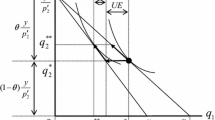Abstract
A dual vista of an intertemporal model of the consumer yields insights into its fundamental qualitative structure that previous research was heretofore unable to uncover. For example, the intertemporal Slutsky matrix and its properties of symmetry and negative semidefiniteness apply to the integral of the discounted open-loop demand and supply functions, not to the instantaneous open-loop demand and supply functions. The results are established in a general dynamic model of the consumer which accounts for durable and nondurable goods, installation costs for the durable goods, and a leisure/labor choice.
Similar content being viewed by others
References
Boyce, W. E., and DiPrima, R. C. (1977):Elementary Differential Equations and Boundary Value Problems, 3rd ed. New York: John Wiley.
Caputo, M. R. (1990): “How to Do Comparative Dynamics on the Back of an Envelope in Optimal Control Theory.”Journal of Economic Dynamics and Control 14: 655–683.
(1992): “A Primal-Dual Approach to Comparative Dynamics with Time Dependent Parameters in Variational Calculus.”Optimal Control Applications and Methods 13: 73–86.
Clegg, J. C. (1968):Calculus of Variations. New York: Interscience.
Cooper, R. J., and McLaren, K. R. (1980): “Atemporal, Temporal and Intertemporal Duality in Consumer Theory.”International Economic Review 21: 599–609.
El-Hodiri, M. A. (1985): “Properties of Consumers Over Time Demand Functions.” InOptimal Control Theory and Economic Analysis 2, edited by G. Feichtinger. Amsterdam: North-Holland.
Hadley, G., and Kemp, M. C. (1971):Variational Methods in Economics. Amsterdam: North-Holland.
Hartman, P. (1982):Ordinary Differential Equations, 2nd ed. Boston: Birkhäuser.
LaFrance, J. T., and Barney, L. D. (1991): “The Envelope Theorem in Dynamic Optimization.”Journal of Economic Dynamics and Control 15: 355–385.
Lau, L. J. (1976): “A Characterization of the Normalized Restricted Profit Function.”Journal of Economic Theory 12: 131–163.
Silberberg, E. (1990):The Structure of Economics: A Mathematical Analysis, 2nd ed. New York: McGraw-Hill.
(1974): “A Revision of Comparative Statics Methodology in Economics, or How to Do Comparative Statics on the Back of an Envelope.”Journal of Economic Theory 7: 159–172.
Author information
Authors and Affiliations
Rights and permissions
About this article
Cite this article
Caputo, M.R. The Slutsky matrix and homogeneity in intertemporal consumer theory. Zeitschr. f. Nationalökonomie 60, 255–279 (1994). https://doi.org/10.1007/BF01227482
Received:
Issue Date:
DOI: https://doi.org/10.1007/BF01227482




